Frontier
Land & Indians
Land speculation—the process of buying land cheap and then selling it for a higher cost—was part of life in the Tennessee region before and after the Revolutionary War.
Since Indians lived on the land, it was necessary to get rights from the Indians—usually through a treaty—before the land could be sold to settlers.
One of the largest land deals was the Sycamore Shoals Treaty in 1775. Richard Henderson, a judge in North Carolina, formed a land company with others called the Transylvania Company. He invited Cherokee leaders to Sycamore Shoals to discuss purchasing some 20 million acres of land in Middle Tennessee and Kentucky.
Nearly 1,200 Indians showed up for the treaty negotiations. Despite the protests of Dragging Canoe, who correctly warned that white settlers would try and take all their land, three Cherokee chiefs signed the treaty. Even though the treaty was later declared illegal, settlers began moving into the new lands.
Men like William Blount and John Sevier had gambled on the outcome of the Revolution, betting that the British would be beaten, thus freeing western lands for settlement. Sevier was even implicated by the State of North Carolina for his role in awkward land dealings. Still, he was elected to serve three terms as governor. Even while serving as governor, Sevier continued in land speculation.
State officials in North Carolina (which included Tennessee in its boundaries) designated a large area of Middle Tennessee as land reserved for military veterans. Veterans who had served during the Revolutionary War could claim free land as their own. Land speculators bought up the land grants from veterans who didn’t want to move that far west, and then resold them to other settlers. They sometimes sold the same piece land more than once—causing lawsuits in the courts.
Land speculation often had negative consequences. Native American lands were sometimes claimed by speculators, leading to bitter conflicts and unfair treaties.
Native Americans only had two options when fighting land speculation. One was accommodation--trying to get along with the settlers, even to the point of adopting U.S. customs of clothing and housing to appease settlers. Some, like Cherokee leader Nancy Ward, supported accommodation because they felt that Indians were outnumbered and could not win a war with settlers.
Others, like Dragging Canoe, believed that war was the only option. After the Creeks were defeated during the War of 1812, the path of accommodation seemed the only way for the Native Americans to retain their Tennessee lands.
Mixed-blood men like trader John McDonald, whose grandson John Ross later was a prominent Cherokee leader, became primary spokesmen for Native tribes because of their familiarity with both settler and Indian culture. Some personally profited from their dealings with whites. For example, George Colbert opened a profitable ferry on the Tennessee River in exchange for a federal wagon road through Chickasaw territory.
Still, the hunger for new lands was too much for speculators, and Indian efforts at accommodation were not enough to stave off removal for very long. Despite the efforts of Indian leaders, Indian tribes in Tennessee ultimately lost all their land.
Picture Credits:
- Photograph of Chisholm Tavern. This photo was taken in 1933 in Knoxville, Tennessee. It shows what Chisholm Tavern, owned by John D. Chisholm, may have looked like in 1792. Library of Congress.
- Print of Judge Richard Henderson. North Carolina State Archives
- Drawing of the Treaty at Sycamore Shoals. This drawing was created by illustrator Bernie Andrews and originally published in The Overmountain Men by Pat Alderman in 1986. It shows leaders of the settlers and Cherokee Indians signing a document upon a tree stump. Numerous settlers, Cherokee, and small dwellings are also shown. Tennessee State Museum Collection
- Photograph of two re-enactors dressed as a Cherokee Indian and a white settler. It shows the two walking through the woods. Natural Resources Conservation Service
- Drawing entitled, “Christian Expedition against the Cherokees in East Tennessee.” This drawing was published in 1968 by Mary French Caldwell in her work, Tennessee: The Volunteer State. It shows a guide leading several men through a swampy area. Tennessee State Museum Collection, Bettman Archives
- Drawing showing a scene during the Creek Wars from 1813-1814. This drawing was made in 1855 and published in Harper’s New Monthly Magazine. It shows Creek Indians using rifles to fight with several uniformed and armed men. Tennessee State Museum Collection
Frontier >> Becoming a State >> Early Efforts >> Land & Indians
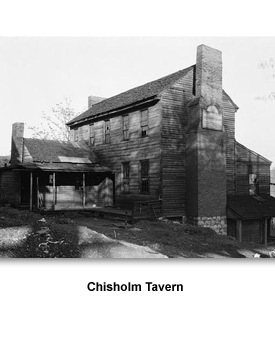
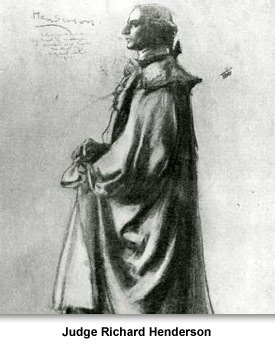
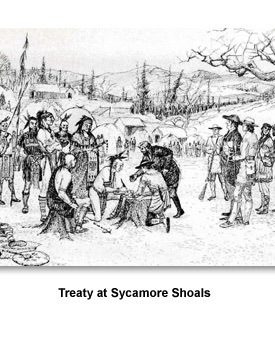
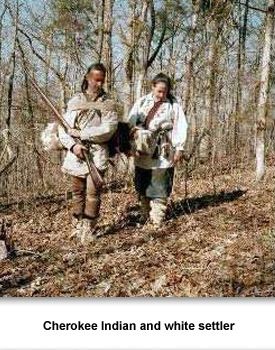
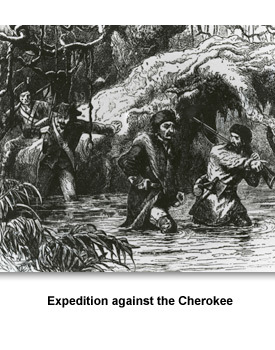
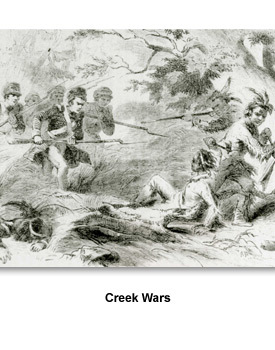
 Sponsored by: National Endowment for the Humanities
Sponsored by: National Endowment for the Humanities